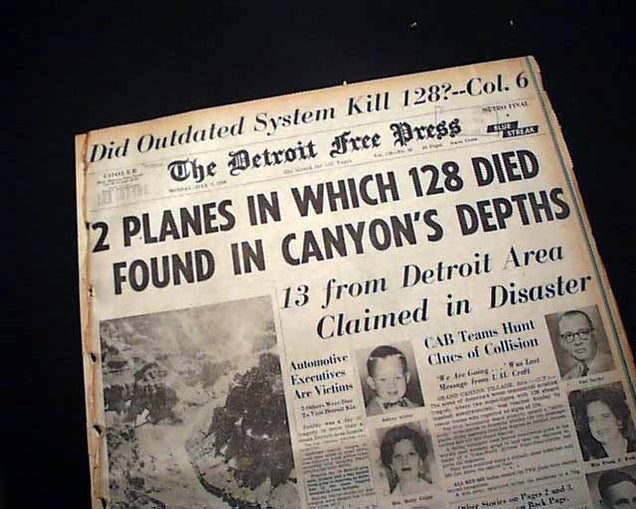
In 1956 two planes collided over the Arizona desert, killing all 128 people on board and scattering the debris deep inside the Grand Canyon. This week, the National Park Service designated the crash site a National Historic Landmark—even though they don't actually want you to go visit it.
At the time, the tragedy was the deadliest civilian plane crash on American soil. It also served as a devastating wakeup call to the fledgling airline industry, which was suffering from growing pains and lack of government support.
A United Airlines DC-7 and TWA Lockheed L-1049 Super Constellation both left LAX on the morning of June 30, 1956, the United flight headed to Chicago Midway and the TWA flight headed to Kansas City. Both planes were flying at different altitudes in uncontrolled airspace when the TWA flight requested permission from air traffic control to fly at higher than normal altitudes due to thunderstorms. Air traffic control said no, due to the United flight nearby. Then the pilot requested to ascend above cloud level, operating under visual flight rules or VFR (instead of instrument flight rules). It was understood that at this altitude, the pilot would be employing the "see and be seen" principle—responsible for visually spotting and avoiding planes nearby.
The planes knew they would be sharing airspace but did not have any way of knowing they were in such close proximity. It's also likely that both planes were off-course slightly to show their passengers the scenic landscape below. As the two pilots headed over the Grand Canyon, clouds probably obscured their views, and the planes collided at a 25-degree angle.
Although there's a burial site for the TWA passengers in nearby Flagstaff, Arizona, the crash site itself has never been formally recognized. For one, they're not exactly sure where the crash itself happened. The planes hit the ground at 700 feet per second near the confluence of the Colorado and Little Colorado Rivers. Each ignited fires that were so hot they fused the body of the plane onto the canyon rocks. No bodies were recovered intact.
There are parts of the planes which remain at the bottom of the canyon; due to the treacherous terrain it was impossible to recover all the pieces. But also due to that treacherous terrain, the National Park Service is not revealing the exact location of the crash site because it doesn't want people hiking there.
So why even have a landmark at all? In this case, the landmark status is more about the changes this site brought about. Because of the crash, the country enacted sweeping reforms for communication and safety for the airline industry. Due to the heavy press coverage the crash received, the public was outraged, and there was a movement to demand congressional hearings about the case. Between 1950 and 1955 there had already been 65 mid-air collisions over U.S. airspace.

In 1957, a motion was introduced to boost air traffic control funding, both to modernize the system and hire and train controllers. This would include ways to better manage visual and instrument flight rules. Airports also added radar, which would prove invaluable for tracking planes. And a few years later, the Federal Aviation Agency was formed to oversee all American airspace.
Although memorials for crash sites are commonplace, this is the first time a plane crash site has been landmarked. And it's also the first landmark which technically honors something which happened in the air, not on the ground, National Historic Landmarks Program branch chief Alexandra Lord told The Atlantic Cities:
"We've never done an actual crash site," said Alexandra Lord, branch chief of the National Historic Landmarks Program in Washington, D.C. "In some ways we can argue that the crash itself—which led to the scattering of pieces over a huge debris field—is what's crucial. And it sort of doesn't matter if you think of it as on the air or on the ground."
Next time you're flying over the American Southwest and your pilot tells you to look out the window to see the Grand Canyon, know that the reason you're flying safely is because of that site somewhere below. A single tragic crash spurred along the technology that made the skies a better place for all. And for that, a landmark is very fitting indeed.
Monday 28 April 2014
http://gizmodo.com/why-a-1956-plane-crash-site-in-the-grand-canyon-was-nam-1568330158

0 comments:
Post a Comment